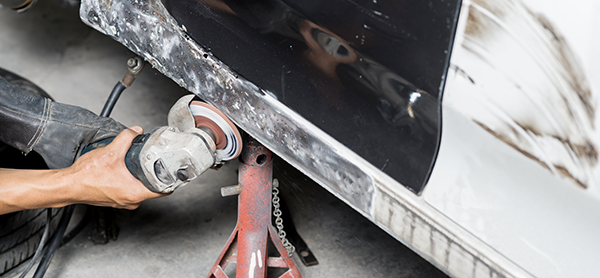P2 Section #4 | Collision Repair & Refinishing - Pg 1

Section 4 | Collision Repair & Refinishing
Revised On: March. 17, 2024 - 8:00 p.m.
Learning Objectives:
- Define what auto body repair is.
- Identify the common processes such as welding, grinding, and auto body filler.
- Identify the waste and its harm to the environment and human health.
- Identify regulatory considerations for auto body repair waste.
- Determine if there are P2 opportunities for your auto body repair process.
Auto Body Repair
Auto body repair involves identifying and repairing any damage sustained by a vehicle during an accident or collision. This can include repairing or replacing damaged body panels, frame straightening, and ensuring the vehicle's structural integrity is restored to its pre-accident state. Skilled technicians, such as yourself, use specialized tools and equipment to assess and repair the damage carefully, ensuring the vehicle is safe to operate. When performing such tasks, some wastes come from welding, grinding, and auto body filler. In this lesson, we will focus on what these wastes are. In addition, we’ll learn about the different environmental and health considerations for the type of common processes you work with daily.
First, let’s talk about the common processes and their wastes in your workplace. Welding, grinding, and auto-body filler are high-level techniques that allow you to successfully repair a vehicle's body but generate lots of waste. The waste you are most likely to encounter will come from sanding, cutting, and grinding, as well as the body filler your shop may use. As you may know, this is a material used to repair and restore vehicle body panels and to fill dents, dings, scratches, and other imperfections found on metal and other surfaces before painting.
Welding
Welding uses high heat to combine metal pieces with a filler material. Arc welding is most commonly used in the automotive industry, such as metal inert gas (MIG) or tungsten inert gas (TIG) welding. The high heat used in welding causes metal fumes and other gas by-products to emit. Welding fumes can contain toxic heavy metals such as manganese or chromium. This causes health impacts, such as:
- Nose and throat irritation with dizziness and nausea through inhalation
- Eye irritation through contact with the fumes
- Prolonged exposure can cause respiratory damage and various types of cancer.
The exact metals you are exposed to vary with welding types, fillers, car models, and year produced. If you are in an enclosed or not in a well-ventilated area, the buildup of carbon dioxide or carbon monoxide gasses can cause suffocation.
Heavy metals entering the environment carry these toxic elements into nature. These metals are found naturally, but human activities can increase concentrations to harmful levels. These metals can leach into the soil and water, posing risks to aquatic life and potentially contaminating drinking water sources. Heavy metals can also inhibit plant growth and eventually lead to plant death.
Cutting and Grinding

Cutting and grinding pose health and environmental hazards similar to welding. While welding produces fumes, grinding and cutting produce fine metal particles that can flake off, as sanding discs eject small particles of silica, rust, and metals. These particles can accumulate in the lungs, leading to severe respiratory issues for workers. However, it's not just the lungs at risk, as the liver, kidneys, skin, and mucous membranes can also be affected. Without proper ventilation and personal protective equipment (PPE), chronic health problems can arise. Another concern is the impact of heavy metals on the environment and public health. Air and water pollution caused by heavy metals can lead to heavy metal poisoning with symptoms ranging from confusion and nausea to coma.
Auto Body Filler

Auto body filler is commonly used in the automotive maintenance industry and encompasses many components you may have used or dealt with. Some examples of auto-body filler include resin, filler material, catalysts, filler solvents, and additives. Resin, the primary component of body filler, provides the adhesive and binding properties of the material. Filler materials are mixed with the resin to create a thick paste-like consistency. The filler material is usually made of fine particles of talc or calcium carbonate. These particles give the body filler the ability to fill gaps and imperfections. A hardening agent used as a catalyst is added to the resin and filler mixture. This catalyst initiates a chemical reaction that causes the material to harden and cure. Filler solvents dissolve the resin and allow the filler material to mix evenly. These solvents evaporate during the curing process, leaving behind the hardened body filler. Additives are the final process, and some fillers might include additives for improved adhesion, flexibility, or stand-ability. All these processes are very commonly used, as I’m sure you have encountered them in your shop, but there are health and environmental considerations when using them.
The components of auto-body filler can impact human health by potentially leading to
- Respiratory irritation through inhalation causes coughing, throat irritation, and difficulty breathing.
- Skin irritation through contact leads to redness, itching, and dermatitis.
- Eye irritation through splashes or exposure causes redness and tearing.
- Cancer risk: some hydrocarbon solvents have been classified as possible or probable carcinogens by organizations like the International Agency for Research on Cancer (IARC).
The environmental effects can come in various forms, and it all starts with you and how you properly handle, dispose and mitigate accidents. Some components found in solid waste from collision repair, such as metals and plastic materials, can leach chemicals into the soil and water if disposed of improperly. While the contamination risk is generally lower than hazardous waste, it can still have localized environmental effects. The generation of dust and particulate matter from sanding, grinding, and other repair processes can affect the air quality within the workshop and its surroundings. While not typically hazardous, these particles can contribute to poor indoor air quality and increase fire risk if improperly managed. Disposing of plastics and metals in landfills depletes natural resources and causes environmental harm. However, both materials can be recycled and repurposed.
Mitigating the Impact
Recycling scrap metal is an important way to reduce waste, even though pollution prevention may not be considered. When we recycle scrap metal, we can avoid the need to extract new metals. Mining activities are resource-intensive and generate significant air and water pollution. By recycling scrap metal, we can reduce the burden on the land, especially in areas already damaged by mining. Additionally, recycling scrap metal can be profitable for businesses as it is a valuable resource with many applications beyond the automotive industry. This can help create new products using existing materials and support local jobs. Furthermore, businesses that recycle metal may be eligible for tax incentives, which can save them money that can be invested in more on-site projects.

P2 Opportunities
Remember that P2 opportunities target waste generation at its source. In the case of auto body repair, this usually means that the waste generated from welding, sanding, and body filler must be minimized, and best management practices must be utilized to reduce accidents and overuse. Here are a few options for lowering auto body repair waste:
- Manage your use of auto body filler using inventory control. Tracking auto body filler is a way to prevent overuse and promote more careful product use.
- Scrap metal recycling and reuse. Waste reduction strategies should also be implemented in industries that generate scrap metal. This could include process improvements to minimize material waste and optimize metal use. Your shop can also invest in technologies that recover valuable metals from discarded products, reducing the need for mining and new metal production.
- Welding ventilation is key to reducing exposure to and releases of welding fumes. This can be achieved through purpose-built fume extractor equipment positioned to extract welding fumes from any welding activity at your facility.
In the next lesson, we will talk about material preparation.
